Archive for May, 2011
A Trio of Virginia Wineries
I'm planning to add some reviews of the wineries I like, but that will take a bit more time than I have today. So, for now, I'm just going to offer a list of three wineries in the Monticello AVA that I am particularly fond of. And there is a theme here: these are the three wineries who came together to make a wine they named (appropriately enough) "3."
Emily Pelton of Veritas Vineyards stands behind bottles of "3" wine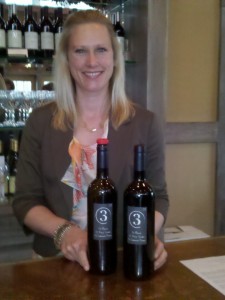
Each of the three contributed one of the varietals to the blend. Pollak Vineyards provided the Petit Verdot, Veritas Vineyard and Winery supplied the Cab Franc, and King Family Vineyards contributed the Merlot grapes. In theory, they planned to blend one third each of the grapes, but in practice, I think they realized that a blend required some judgment, and would likely end up being something other than one-third each. When blending wines, as I learned from King Family winemaker Matthieu Finot, you spend a lot of time experimenting and tasting. In this particular blend, I'm guessing that the Petit Verdot was very powerful, and they may have decided to use less of it and more of either of the other two grapes.
No matter. The wine was fabulous, and since they only made 150 cases, it sold out quickly. Each customer at Veritas was limited to three bottles at $33.33 each — yes, they carried the 3 theme pretty far — and I personally think this one will age quite well. So my three bottles are stored in my EuroCave wine celler, waiting for that perfect moment in the near future when they will achieve perfection.
The Vines Emerge into the Sunlight!
- After two weeks, this Cab Franc vine emerges from the earth
- Three Cab Franc in the foreground, two Mammolo in the background
At long last — actually, it was only two weeks — the Cab Franc vines emerged from the soil. When we planted the vines, the graft union — the large swollen area where the root stock and the scion met — was hilled over, which is to say, we made a mound of dirt to cover the graft union. The graft union very quickly sent shoots up, and so this weekend, we removed the dirt that we had mounded over the vine, sprayed for all the diseases that Virginia humidity and (especially) rain can bring, and then place the blue-x grow tubes over the vines.
In this gallery, you see on the ends (I was having a problem with the software, and it was just easier to keep two of the same picture on the ends) a picture of three of the five Cab Franc vines, plus two of the Mammolo Tuscano that we planted earlier, the Mammolos being a gift from Gabrielle Rausse, one of Virginia’s great winemakers. In the middle, is a picture of the vine that emerged from the graft union that was still buried.
As Gabrielle said to us in a class, “the vine is so smart.” It definitely knows what to do. A small cutting from the vine can be made to both bud at one end — giving rise to a vine that will bear fruit — and take root at the other. Unfortunately, Vitis Vinifera vines from Europe cannnot grow on their own roots here in the U.S. They will die from Phylloxera (which nearly destroyed the entire wine industry in Europe in the 19th century) or some other North American disease. To survive, the Vinifera vine must be grafted onto American rootstock. The rootstock my vines are grafted onto is known as 101-14.
With luck, we’ll be making wine from these vines in three short years!
Bob
A Vineyard Management class at DuCard Vineyards
Saturday's vineyard management class was the second of four at DuCard Vineyards, in Etlan, Virginia. We've been working with a section of Norton vines, and we'll be seeing them through until the harvest. Lots of work done is while we're not there (spraying, among other things), but we're doing much (well, some) of the essential work on the vines.
Scott Elliff, the vineyard's owner, has been migrating his vineyard from a Geneva Double Curtain trellising system to a modified Lyre system, so in our first class, we worked on pruning vines to facilitate that transition. Both GDC and Lyre are divided canopy systems in which the trunk of the vine is planted in the middle of two sets of trellis wires about four feet apart. With GDC, the vines grow downward, like a waterfall on each side of the row. With Lyre, they run up. Continue Reading–>
Planting Vine Number 14
On Sunday, Chris and I planted the last of the dozen Cab Franc vines we had ordered from Double A Nurseries in New York. These vines were a little different from what I had expected, based on the two Mammolo vines that we had received as a gift after a class on grafting. The Mammolos had a large and beautifully blooming scion (which is the actual vine) that had been grafted to phylloxera resistant rootstock. We pruned back the scions to three buds, and planted them. Continue Reading–>

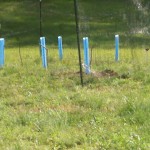
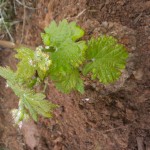
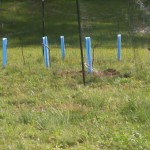
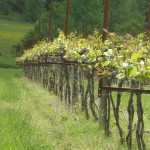

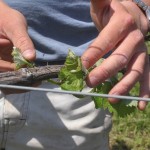
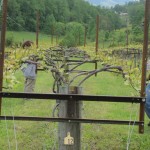
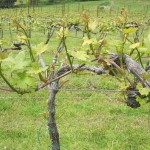
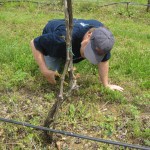


Recent Comments